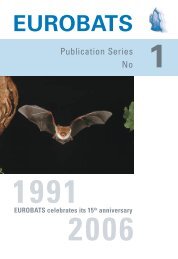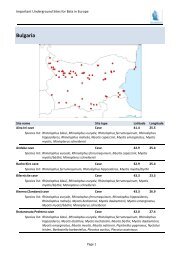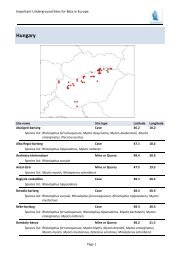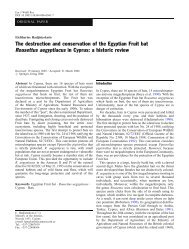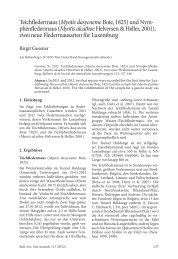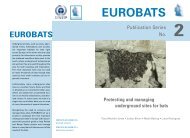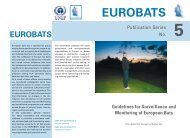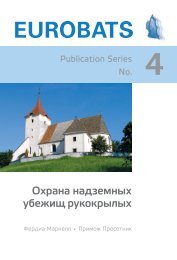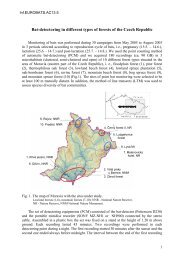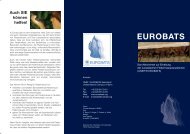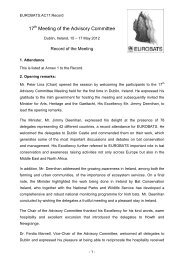Tochni / Larnaca, Cyprus, 11 – 13 May 2009 - Eurobats
Tochni / Larnaca, Cyprus, 11 – 13 May 2009 - Eurobats
Tochni / Larnaca, Cyprus, 11 – 13 May 2009 - Eurobats
You also want an ePaper? Increase the reach of your titles
YUMPU automatically turns print PDFs into web optimized ePapers that Google loves.
Doc.EUROBATS.AC14.9.Rev.1<br />
14 th Meeting of the Advisory Committee<br />
<strong>Tochni</strong> / <strong>Larnaca</strong>, <strong>Cyprus</strong>, <strong>11</strong> – <strong>13</strong> <strong>May</strong> <strong>2009</strong><br />
Report of the IWG on Wind Turbines and Bat populations<br />
Members<br />
Luísa Rodrigues (Convenor; Portugal), Marie-Jo Dubourg-Savage (SFEPM, France), Lothar<br />
Bach (Germany), Christine Harbusch (NABU, Germany), Tony Hutson (IUCN, United<br />
Kingdom), Laurent Biraschi (Luxembourg), Alison Elliot (United Kingdom), Eeva-Maria<br />
Kyheröinen (Finland), Kaja Lotman (Estonia), Lauri Lutsar (Estonian Fund for Nature, Estonia),<br />
Per Ole Syvertsen (Norway), Jacques Pir (Luxembourg)<br />
Subgroups<br />
To simplify the work, several sub-groups were created:<br />
Sub-group Coordinator (c) and members<br />
1) preparation of an Excel file of references Marie-Jo<br />
2) compilation of data on bat mortality per country Marie-Jo (c), Lothar<br />
3) preparation/analysis of a questionnaire Laurent (c), Eeva, Lauri, Jacques<br />
4) updating of tables Christine (c), Marie-Jo<br />
5) mitigation and compensation measures Luisa (c), Lothar<br />
6) estimation of mortality rate taking into consideration predation and Lothar (c), Luisa<br />
efficiency<br />
7) impact of mortality rate on populations Christine (c), Lothar, Luisa<br />
8) deterrents Lothar (c), Luisa<br />
Results<br />
Results are presented by sub-group.<br />
1) Preparation of an Excel file of references<br />
Annex 1 contains a list of new references on this subject. Apart from those which refer directly<br />
to bats and wind turbines, there are also references on new techniques to assess the impacts of<br />
Wind Turbines and on migration.<br />
2) Compilation of data on bat mortality per country<br />
Annex 2 contains an updated table with data on bat mortality per country. The table presents<br />
the number of fatalities per species. The IWG recalls the countries to send their data, to<br />
complete the table.<br />
3) Preparation/analysis of a questionnaire<br />
A questionnaire was sent to all Parties and Non-Parties Range States. 27 replies were received,<br />
and 3 countries informed that there are no wind farms in their territories. The replies are being<br />
analysed as far as possible before the Meeting, and a report will be prepared during the AC<br />
Meeting.<br />
4) Updating of tables<br />
- 1 -
Annex 3 contains new data about studies done in Europe; this table is an update to Table 1 of<br />
EUROBATS Publication Series nº 3. The IWG recalls the countries to send their data, to<br />
complete the table.<br />
5) Mitigation and compensation measures<br />
There are some measures suggested in the bibliography, but there are no references about<br />
their application. They include:<br />
- site selection:<br />
• avoidance of flyways (Ahlén et al. 2007)<br />
• avoidance of forests (NLT 2005, Regierungspräsidium Freiburg 2006, LANU 2008)<br />
• avoidance of insect rich habitats as rivers, lakes etc. (Ahlén et al. 2007, LANU<br />
2008)<br />
• avoidance of woodland areas (buffer zone at least 200 m) (NLT 2005,<br />
Regierungspräsidium Freiburg 2006, LANU 2008, Rodrigues et al. 2008)<br />
• buffer zone of at least 50 m from any habitat features or structures suitable for<br />
roosts (Dürr 2007, Natural England <strong>2009</strong>)<br />
• buffer zone of at least 500 m from maternity roosts (NLT 2005, LANU 2008)<br />
• buffer zone of at least 500 m from any nature protection areas incl. Natura 2000<br />
areas (NLT 2005)<br />
- operation:<br />
• stop turbines during periods of high risk, including parts of the night, weeks in the<br />
season, and weather situations (e.g. low wind speed) (Ahlén et al. 2007, Dürr<br />
2007)<br />
• lock blades in place while turbine is not operating (Smallwood 2006)<br />
• synchronize the operations of wind turbines in a row of turbines to be on and off at<br />
the same times (Smallwood 2006)<br />
• reduction of the amount of flying insects around the tower and blades (Ahlén et al.<br />
2007)<br />
• removal or relocating if fatalities are concentrated at specific turbines (Arnett et al.<br />
2008)<br />
• remove broken and non-operating wind turbines (Smallwood 2006)<br />
- other:<br />
• subsidies for maintenance of trees that are potential roosts (ICNB <strong>2009</strong>)<br />
• installation of bat-boxes and other alternative roosts (ICNB <strong>2009</strong>)<br />
• promote public awareness (ICNB <strong>2009</strong>)<br />
• protect feeding habitats (restoration of riparian vegetation, pesticides decrease)<br />
(ICNB <strong>2009</strong>)<br />
• improvement of potential foraging habitats or roosts away from the WT area<br />
(Harbusch & Bach 2005)<br />
- 2 -
Ahlén, I., L. Bach, H.J. Baagøe, & J. Pettersson (2007) Bats and offshore wind turbines studies<br />
in southern Scandinavia. Report to the Swedish Environmental Protection Agency: 37 pp.<br />
Arnett; B.E., Brown, W.K., Erickson, W.P., Fiedler, J.K., Hamilton, B.L., Henry, T.H., Jain, A.,<br />
Johnson, G.D., Kerns, J., Koford, R.R., Nicholson, C.P., O´Connell, T.J., Piorkowski, M.D.<br />
& R.D. Tankersley (2008) Patterns of Bat Fatalities at Wind Energy Facilities in North<br />
America. Journal of Wildlife Management 72(1): 61-78.<br />
Dürr, T. (2007) Möglichkeiten zur Reduzierung von Fledermausverlusten an<br />
Windenergieanlagen in Brandenburg. Nyctalus 12(2-3): 238-252.<br />
Harbusch, C. & L. Bach (2005) Environmental Assessment Studies on wind turbines and bat<br />
populations - a step towards best practice guidelines. Bat News 78: 4-5.<br />
ICBN (<strong>2009</strong>) Orientações internas para avaliação de projectos de Parques Eólicos, referentes<br />
aos morcegos.<br />
LANU (2008) Empfehlungen zur Berücksichtigung tierökologischer Belange bei<br />
Windenergieplanungen in Schleswig-Holstein. Schriftenreihe LANU SH- Natur <strong>13</strong>: 1-90.<br />
Natural England (<strong>2009</strong>) Bats and onshore wind turbines - Interim guidance. Natural England<br />
Technical Information Note TIN051.<br />
NLT (2005) Hinweise zur Berücksichtigung des Naturschutzes und der Landschaftspflege sowie<br />
zur Durchführung der Umweltprüfung und Umweltverträglichkeitsprüfung bei<br />
Standortplanung und Zulassung von Windenergieanlagen: 1-31.<br />
Regierungspräsidium Freiburg (2006) Auswirkungen von Windkraftanlagen auf Fledermäuse.<br />
Ergebnisse aus dem Regierungsbezirk mit einer Handlungsempfehlung für die Praxis: 1-<br />
<strong>11</strong>.<br />
Rodrigues L., L. Bach, M.-J. Dubourg-Savage, J. Goodwin & C. Harbusch (2008) Guidelines for<br />
consideration of bats in windfarm projects. EUROBATS Publication Series nº 3.<br />
Smallwood S. (2006) Adaptive Management, Mitigation, and Future Siting. AWEA / Audubon<br />
Workshop: Understanding and Resolving Bird and Bat Impacts.<br />
6) Estimation of mortality rate taking into consideration predation, efficiency and %<br />
of area controlled<br />
Due to the increasing perception of the problematic of wind turbines and bats, several postmonitoring<br />
studies have been done during the last years throughout Europe. Unfortunately, only<br />
few studies take correction factors into account (see table 1), and there is no consensus about<br />
the applicability of different formulas. Different groups prefer different formulas (e.g.<br />
Winkelmann 1992, Johnson et al. 2003, Erickson et al. 2004, Arnett 2005, Grünkorn et al. 2005,<br />
Kerns et al. 2005). But to be able to compare estimation of fatalities/WT/year, it is necessary to<br />
apply not only investigations for the estimation of search efficiency and predator bias but also<br />
the same correcting factors everywhere. Momentary two new approaches in Germany<br />
(Brinkmann pers. comm.) and USA (Huso pers. comm.) are under development.<br />
Another problem and even more important s that most of the post-monitoring studies (e.g. in<br />
Germany) are not published or otherwise officially available. Wind farm developers must be<br />
forced to make all reports available, to allow an overview over a broader geographical scale and<br />
to increase the knowledge about mortality rate.<br />
The mortality is highly variable between different sites. But it seems that close or inside forests<br />
and in areas with bat migration immediately at the shore line the mortality is highest. Beside that<br />
the mortality varies between years (see Brinkmann et al. 2006, Dulac 2008).<br />
- 3 -
TABLE 1.—Bat mortality at wind farms in different European landscapes and the different use of correction<br />
factors (Y = done, * = lower range with 2 correction factors, higher range with 3 correction factors)<br />
Investigation<br />
numbers<br />
of WT<br />
collision rate<br />
bats/WT/year<br />
searcher<br />
efficiency<br />
bias<br />
- 4 -<br />
carcass<br />
removal<br />
bias<br />
% of<br />
effectively<br />
searched<br />
area per WT reference<br />
Freiburg - 2004 16 20,9 Y Y Brinkmann et al. 2006<br />
Freiburg - 2005 8 <strong>11</strong>,8 Y Y Y Brinkmann et al. 2006<br />
Fröhnd - 2005 2 16,5 Y Y Behr et al. 2006<br />
Rosskopf -2005 4 31,5 Y Y<br />
Behr and v. Helversen<br />
2006<br />
Switzerland - 2007 8 8,2 Leuzinger et al. 2008<br />
North Sea coast - 2008 5 1,9 Y Y Y Bach and Bach 2008<br />
Schleswig-Holstein -<br />
2004 24 0 Y Y<br />
Grünkorn et al. 2005<br />
Bouin - 2004 8 20,3 - 21,6* Y Y Y Dulac 2008<br />
Bouin - 2005 8 21,5 - 26,7* Y Y Y Dulac 2008<br />
Bouin - 2006 8 6,0 - 9,3* Y Y Y Dulac 2008<br />
North Sea coast - 1990 <strong>13</strong>0 0 Vauk et al. 1990<br />
Oberdorf - 2004 5 0 Traxler et al. 2004<br />
Prellenkirchen - 2004 8 8 Traxler et al. 2004<br />
Steinberg - 2004 9 5,33 Traxler et al. 2004<br />
Aragon - 1999 ? 10,15 Latorre and Zueco 1998<br />
Navarra II 10 <strong>13</strong>,3<br />
Navarra I 10 3,09<br />
Lekuona 2001, Petri and<br />
Munilla 2002<br />
Lekuona 2001, Petri and<br />
Munilla 2003<br />
Saxony (16 WP) - 2004 92 1,5 Endl et al. 2005<br />
Saxony I - 2004 10 4,6 Endl et al. 2005<br />
Saxony II - 2004 10 1,1 Endl et al. 2005<br />
Saxony (<strong>11</strong> WP) - 2006 26 0,9 Seiche et al. 2007<br />
Portugal (Seixinhos) -<br />
2006 8 1,86 Y Y<br />
Portugal (Lameira) –<br />
2006/2007 8 0,63<br />
Y Strix 2007<br />
Ecosistema 2007<br />
Portugal (Outeiro) – 2006 15 5,98 Y Y Y Profico Ambiente 2007<br />
Portugal (Outeiro) –<br />
Spring 2008 15 1,86<br />
Cabral et al. 2008<br />
Arnett, E.B., W.P. Erickson, & J. Kerns (2005) Relationships between Bats and Wind Turbines<br />
in Pennsylvania and West Virginia. A final report prepared for the Bats and Wind Energy<br />
Cooperative (BWEC): 1-187.<br />
Bach, L. and P. Bach (2008) Monitoring der Fledermausaktivität im Windpark Cappel.-Neufeld –<br />
Zwischenbericht 2008. unpubl. Report to WWK: 1-29.<br />
Behr, O., D. Glaubitz, U. Marckmann, H. Mette-Christ, K. Moch, N. Reisinger and V. Runkel<br />
(2006) Gutachten zur Beeinträchtigung im freien Luftraum jagender und ziehender<br />
Fledermäuse durch bestehende Windkraftanlagen – Wirkungskontrolle zum Windpark<br />
„Ittenschwander Horn“ bei Fröhnd im Schwarzwald im Jahr 2005. Unpubl. report on behalf<br />
of Windpark Fröhnd GmbH & Co KG.
Behr, O. and O. von Helversen (2006) Gutachten zur Beeinträchtigung im freien Luftraum<br />
jagender und ziehender Fledermäuse durch bestehende Windkraftanlagen.<br />
Wirkungskontrolle zum Windpark „Roßkopf“ (Freiburg i. Br.) im Jahre 2005. Unpubl. report<br />
for 2005 on behalf of Regiowind GmbH & Co. KG Freiburg: 1-32.<br />
Brinkmann, R., H. Schauer-Weisshahn and F. Bontadina (2006) Untersuchungen zu möglichen<br />
betriebsbedingten Auswirkungen von Windkraftanlagen auf Fledermäuse im Regierungsbezirk<br />
Freiburg. Report for Regierungspräsidium Freiburg by request of Naturschutzfonds<br />
Baden-Württemberg: 66 pp.<br />
Cabral, J.A., P., Silva-Santos, P. Barros, C. Silva, J., Correia, R. Gonçalves, and L. Braz<br />
(2008) Programa de monitorização da actividade e mortalidade de quirópteros – Parque<br />
Eólico do Outeiro (Inverno e Primavera - Fase de Exploração). Estudo do Laboratório de<br />
Ecologia Aplicada da Universidade de Trás-os-Montes e Alto Douro para a FINERGE.<br />
Relatório de Progresso (Progress Report).<br />
Dulac, P (2008) Evaluation de l'impact du parc éolien de Bouin (Vendée) sur l'avifaune et les<br />
chauves-souris. Résultats du suivi 2006 et bilan de 5 années de suivi. Unpubl. report on<br />
behalf of Ligue pour la Protection des Oiseaux délégation Vendée / ADEME Pays de la<br />
Loire / Conseil Régional des Pays de la Loire, La Roche-sur-Yon – Nantes, <strong>11</strong>1 pp.<br />
Ecosistema (2007) Monitorização da mortalidade de aves e quirópteros no Parque Eólico da<br />
Lameira. Relatório final. (Final Report)<br />
Endl, P., U. Engelhart, K. Seiche, S. Teufert and H. Trapp (2005) Untersuchungen zum<br />
Verhalten von Fledermäusen und Vögeln an ausgewählten Windkraftanlagen im Landkreis<br />
Bautzen, Kamenz, Löbau-Zittau, Niederschlesischer Oberlausitzkreis, Stadt Görlitz<br />
Freistaat Sachsen. Unpubl. report for Staatliches Umweltfachamt Bautzen: <strong>13</strong>5 pp.<br />
Erickson, W.P., J. Jeffrey, K. Kronner, & K. Bay (2004) Stateline Wind Project Wildlife<br />
Monitoring Final Report, July 2001 – December 2003. Technical report peer-reviewed by<br />
and submitted to FPL Energy, the Oregon Energy Facility Siting Council, and the Stateline<br />
Technical Advisory Committee.<br />
Johnson, G., W.P. Erickson, M.D. Strickland, M.F. Shepherd, & D.A. Shepherd (2003) Mortality<br />
of Bats at a Large-scale Wind Power Development at Buffalo Ridge, Minnesota. Am. Midl.<br />
Nat. 150:332–342<br />
Grünkorn, T., A. Diederichs, B. Stahl, D. Dörte and G. Nehls (2005) Entwicklung einer Methode<br />
zur Abschätzung des Kollisionsrisikos von Vögeln an Windenergieanlagen. Unpubl. report<br />
for Landesamtes für Natur und Umwelt Schleswig-Holstein: 92 pp.<br />
Kerns, J, W. P. Erickson, and E. B. Arnett (2005) Bat and bird fatality at wind energy facilities in<br />
Pennsylvania and West Virginia. Pages 24–95 in E. B. Arnett, editor. Relationships<br />
between bats and wind turbines in Pennsylvania and West Virginia: an assessment of bat<br />
fatality search protocols, patterns of fatality, and behavioral interactions with wind turbines.<br />
A final report submitted to the Bats and Wind Energy Cooperative. Bat Conservation<br />
International, Austin, Texas, USA.<br />
Latorre, F.J.S. and E.P. Zueco (1998) Informe Final “Estudio de seguimiento de la incidencia<br />
del Parque Eolico Borja 1 sobre la avifauna.” Unpubl. report .<br />
Lekuona J. (2001) Uso del espacio por la avifauna y control de la mortalidad de aves y<br />
murciélagos en los parques eólicos de Navarra durante un ciclo anual. Dirección General<br />
de Medio Ambiante Departamento de Medio Ambiante, Ordenación del Territorio y<br />
Vivienda. Gobierno de Navarra<br />
Leuzinger, Y., Lugon, A. and F. Bontadina (2008) Éolienne en Suisse - Mortalité de chauvessouris.<br />
Unpubl. treport for l'OFEV et l'OFEN. 1-37.<br />
Petri, I. and A. Munilla (2002) Gurelur calcula que miles de aves caen en parque eólicos<br />
navarros. Quercus, 197: 50-51.<br />
Profico Ambiente. 2007. Programa de monitorização da mortalidade de aves e quirópteros no<br />
Parque Eólico do Outeiro. Relatório final. (Final report)<br />
- 5 -
Seiche, K., P. Endl and M. Lein (2007) Fledermäuse und Windenergieanlagen in Sachsen –<br />
Ergebnisse einer landesweiten Studie. Nyctalus (N.F.) 12 (2/3): 170-181.<br />
Strix (2007) Plano Especial de Monitorização de Quirópteros para a Serra do Marão – 2006<br />
(Parques Eólicos de Penedo Ruivo, Seixinhos e Teixeiró). Estudo para a EnergieKontor<br />
Portugal Energia Verde. Relatório de Progresso (Progress Report).<br />
Traxler, A., S. Wegleitner and H. Jaklitsch (2004) Vogelschlag, Meideverhalten und<br />
Habitatnutzung an bestehenden Windkraftanlagen Prellenkirchen – Obersdorf –<br />
Steinberg/Prinzendorf. Unpubl. report for WWS Ökoenergie, EVN Naturkraft, WEB<br />
Windenergie, IG Windkraft und Amt der Niederösterreichischen Landesregierung: 107 pp.<br />
Vauk, G., M. Böttger, T. Clemens, G. Grote, G. Hartmann, E. Hartwig, C. Lammen and E. Vauk-<br />
Hentzelt (1990) Biolog.-ökol. Begleituntersuchung zum Bau und Betrieb von WEA.<br />
Endbericht. NNA-Berichte (3) Sonderheft: 3-124.<br />
Winkelman, J. E. (1992) De invloed van de Sepproef Windcentrale te Oosterbierum (Fr.) op<br />
vogels. 1: aanvaringsslachtoffers, pp. 71. DLO Instituut voor Bos- en Natuuronderzoek<br />
(Hrsg.), Arnhem.<br />
7) Impact of mortality rate on populations<br />
To our knowledge, no study regarding the impact of mortality by wind turbines on bat<br />
populations was published yet, so this important issue cannot be presently assessed.<br />
8) Deterrents<br />
There are only two groups working with possibilities to deter bats from the surroundings of<br />
blades from wind turbines. Two possibilities are discussed:<br />
1. radar<br />
2. emission of ultrasound noise<br />
Radar:<br />
Nicholls & Racey (2007) studied the activity of bats (mainly Pipistrellus species) in the<br />
surroundings of different radars (3 civil air traffic control radar, 3 weather radar, 4 military ATC<br />
radar). The bat activity was significantly reduced (circa 50%) in habitats exposed to a high<br />
electromagnetic field strength (EMF) of greater than 2 v/m when compared to matched sites<br />
registering EMF levels of zero. The reduction in bat activity was not significantly different at<br />
lower levels of EMF strength within 400 m of the radar. But it is difficult to quantify the relation<br />
more detailed, since no detailed specification on the radar units is presented. Therefore more<br />
studies, especially experiments with different operating frequencies, are needed to measure the<br />
deterrent effect on bats. Both authors are still studying that phenomenon and a second paper<br />
will come during this spring.<br />
Emission of ultrasound noise<br />
The idea is that a bat will be irritated when an emitted noise (broad banded ultra sound<br />
emission) is louder than the incoming echo to the bat (Szewczak & Arnett 2008). Spanjer (2006)<br />
tested Eptesicus fuscus in the lab and found out that there was a significant reduction of<br />
landings in areas with ultra sound emission in none-feeding trials. But there was no significant<br />
reduction of landings in areas with ultra sound emission in feeding trials. The number of bats<br />
- 6 -
passing the area when the device emitted sound was significant lower than when the device<br />
was silent in both none-feeding and feeding trials. The bats captured significant less mealworms<br />
in areas with ultrasound emission than without.<br />
Szewczak & Arnett (2007) have tested the ultrasound device at six different ponds in August<br />
and September 2007 and found out that the activity of bats was reduced up to 90% in areas<br />
with ultrasound broadcast and they did not observe any habituation. Problematic is the small<br />
range (12 m) of ultrasound broadcast. Horn et al. (2008) tested the acoustic bat deterrent at<br />
Marple Ridge wind farm. The results were different: whereas in one case the bat activity was<br />
significant lower at a deterrent-treated wind turbine it was not so in a second approach case. A<br />
multivariate regression analysis showed a significant relationship between two wind<br />
measurements, barometric pressure, and the presence or absence of the deterrent. Their<br />
results show that several factors influence the effectiveness of deterrent systems. However, it<br />
was also observed that some bats were attracted to these devices (Horn pers. com.).<br />
The results of these studies show that bat can and will avoid ultrasound emissions. However,<br />
although bats are known to avoid ultrasound clutter, little is known about the behavioural<br />
responses of bats to artificial broadband ultrasound emissions. It must be demonstrated on a<br />
full-size scale that bats both can and will avoid large ultrasound fields before acoustic deterrent<br />
systems can be expected to function effectively at wind farms.<br />
Conclusions:<br />
It is not proved yet that these systems are suitable to deter bats from wind turbines. Besides<br />
that there still exist some other questions/problems that have to be solved. For both systems<br />
nothing is known about possible impacts on other species groups as insects or birds. The<br />
ultrasound device only works on a small range (12-20 m), being too weak to encompass an<br />
entire turbine structure. Furthermore, that device has a limited frequency range, which might<br />
result in a species-specific deterrent effect.<br />
So far none of these two systems can be used as a functional system to deter bats from wind<br />
turbines and therefore cannot be used as a mitigation measure for bats.<br />
Horn, J.W., E.B. Arnett, M. Jensen & T.H. Kunz (2008) Testing the effectiveness of an<br />
experimental acoustic bat deterrent at the Maple Ridge wind farm. Unpubl. Report to<br />
BWEC (Bats and Wind Energy Cooperative) and BCI (Bat Conservation International): 1-<br />
30.<br />
Nicholls, B. & P. Racey (2007) Bats avoid radar installations: Could electromagnetic fields deter<br />
bats from colliding with wind turbines? PloS ONE 2(3): e297.<br />
doi:10.<strong>13</strong>71/journal.pone.0000297.<br />
Spanjer, G. R. (2006.) Responses of the big brown bat, Eptesicus fuscus, to a proposed<br />
acoustic deterrent device in a lab setting. A report submitted to the Bats and Wind Energy<br />
Cooperative (BWEC) and the Maryland Department of Natural Resources. Bat<br />
Conservation International. Austin, Texas, USA.<br />
Szewczak, J. & E.B. Arnett (2007) Field Test Results of a Potential Acoustic Deterrent to<br />
Reduce Bat Mortality from Wind Turbines. Unpubl. Report: 1-14.<br />
- 7 -
Journal of Wildlife Management 72(1): 61-78.<br />
2008 Patterns of Bat Fatalities at Wind Energy<br />
Facilities in North America.<br />
Annex 1<br />
Arnett E.B., Brown, W.K., Erickson,<br />
W.P., Fiedler, J.K., Hamilton, B.L.,<br />
Henry, T.H., Jain, A., Johnson, G.D.,<br />
Kerns, J., Koford, R.R., Nicholson,<br />
C.P., O´Connell, T.J., Piorkowski,<br />
M.D. & R.D. Tankersley<br />
Estudo da Plecotus para a SIIF. Relatório de<br />
Progresso (Progress Report).<br />
Ahlén, I., H. J. Baagøe and L. Bach. <strong>2009</strong> Behaviour of bats during migration and<br />
foraging at sea in Scandinavia .<br />
Alves, P. 2006 Planos de Monitorização de Quirópteros,<br />
nos Parques Eólicos da SIIF – Resultados<br />
da prospecção de cadáveres.<br />
Estudo da Plecotus para a Companhia das<br />
Energias Renováveis da Serra dos Candeeiros.<br />
Relatório de Progresso (Progress Report)<br />
Alves, P., B. Silva and S. Barreiro 2006 Parques Eólicos na Serra dos Candeeiros –<br />
Relatório de Monitorização de Quirópteros.<br />
Relatório 2 – Ano 2005.<br />
First Internat’ Symposium on Bat Migration, Berlin.<br />
Poster. Abstracts: 37<br />
<strong>2009</strong> Bat migration in the western Baltic Sea<br />
Region and possible effects of offshore wind<br />
farms.<br />
Bach L., Ahlén I., Baagøe H.,<br />
Pettersson Jan & Bach P.<br />
in Bremen. Fledermauskundlicher Fachbeitrag.<br />
Harpstedt, 23pp.<br />
Bach L., Hämker S. & Rahmel U. 2007 Untersuchungen von Kollisionshäufigkeit<br />
von ziehenden Fledermäusen mit<br />
Windkraftanlagen<br />
unpubl. Report to WWK: 1-29.<br />
First Internat’ Symposium on Bat Migration, Berlin.<br />
Abstracts: 25<br />
Written communication, 8 pp.<br />
Can. J. Zool. 85: 381-387.<br />
First Internat’ Symposium on Bat Migration, Berlin.<br />
Abstracts: 26<br />
Bach, L. & Bach, P. 2008 Monitoring der Fledermausaktivität im<br />
Windpark Cappel.-Neufeld –<br />
Zwischenbericht 2008<br />
Baerwald E. F. & Barclay R. <strong>2009</strong> Bat migration and wind energy: making the<br />
most of destructive sampling.<br />
Baerwald E.F., D’Amours G.H., Klug <strong>2009</strong> Supplemental Data: Barotrauma is a<br />
B.J. & Barclay R.M.R.<br />
significant cause of bat fatalities at wind<br />
turbines.<br />
Barclay, R., Baerwald E.F. & Gruver 2007 Variation in bat and bird fatalities in wind<br />
J.C.<br />
energy facilities: assessing the effects of<br />
rotor size and tower height.<br />
Behr O., Niermann I. & Brinkmann R., <strong>2009</strong> Measuring the risk of bat-collisions at wind<br />
power plants: acoustic monitoring vs. fatality<br />
searches.<br />
8
Final report to BWE:<br />
www.dbu.de/550artikel27549_147.html<br />
2008 HIWUS - Entwicklung eines<br />
Hindernisbefeuerungskonzeptes zur<br />
Minimierung der Lichtemission an On- und<br />
Off-shore Windenergieparks und -anlagen<br />
unter Besonderer Berücksichtigung der<br />
Vereinbarkeit der Aspekte<br />
Umweltverträglichkeit und Sicherheit des<br />
Luft- und Seeverkehrs.<br />
2008 Programa de monitorização da actividade e<br />
mortalidade de quirópteros – Parque Eólico<br />
do Outeiro (Inverno e Primavera - Fase de<br />
BWE (Bundesverband Windenergie<br />
e.V.)<br />
Cabral, J.A., P., Silva-Santos, P.<br />
Estudo do Laboratório de Ecologia Aplicada da<br />
Barros, C. Silva, J., Correia, R.<br />
Universidade de Trás-os-Montes e Alto Douro<br />
Gonçalves, and L. Braz<br />
para a FINERGE. Relatório de Progresso<br />
Exploração).<br />
(Progress Report).<br />
Cryan, P.M. 2008 Mating behavior as a possible cause of bat J. Wildlife Management 72(3): 845-849.<br />
fatalaties at wind turbines<br />
Cryan, P.M. <strong>2009</strong> Bat migration and wind turbines First Internat’ Symposium on Bat Migration, Berlin.<br />
Poster. Abstracts: 81<br />
Dubourg-Savage M.-J., Bach L. & <strong>2009</strong> Bat mortality in wind farms in Europe. First Internat’ Symposium on Bat Migration, Berlin.<br />
Rodrigues L.<br />
Abstracts: 24<br />
Dürr, T. 2007 Möglichkeiten zur Reduzierung von<br />
Nyctalus 12(2-3): 238-252.<br />
Fledermausverlusten an<br />
Windenergieanlagen in Brandenburg.<br />
Ecosistema 2007 Monitorização da mortalidade de aves e Relatório final. (Final Report)<br />
quirópteros no Parque Eólico da Lameira<br />
First Internat’ Symposium on Bat Migration, Berlin.<br />
Poster. Abstracts: 74<br />
<strong>2009</strong> A summary of bat mortality and activity<br />
studies at Buffalo Mountain windfarm,<br />
Tennesseee, United States.<br />
Fiedler J.K., Hentry T.H. & Tankersley<br />
R.D.<br />
Bat News 78: 4-5.<br />
Conférence du Bureau de coordination énergie<br />
éolienne, « Impacts des éoliennes sur les oiseaux<br />
et chiroptères », Berlin 18.04.2008<br />
Unpubl. Report to BWEC (Bats and Wind Energy<br />
Cooperative) and BCI (Bat Conservation<br />
International): 1-30.<br />
Harbusch, C. & L. Bach 2005 Environmental Assessment Studies on wind<br />
turbines and bat populations - a step<br />
towards best practice guidelines.<br />
Hill R. & Hüppop O. 2008 Fernerkundungsmethoden zur<br />
Untersuchung des Vogelzugs auf FINO1:<br />
Fragen im Zusammenhang mit Off-shore<br />
Windparks (Avitec)02/05/<strong>2009</strong>.<br />
http://www.wind-eole.com/fr/node/587<br />
Horn J.W., Arnett E.B. , Jensen M. & 2008 Testing the effectiveness of an experimental<br />
Kunz T.H.<br />
acoustic bat deterrent at the Maple Ridge<br />
wind farm.<br />
Journal of Wildlife Management 72(1): 123-<strong>13</strong>2.<br />
Horn, J.W., Arnett E.B. & Kunz T.H. 2008 Behavioural responses of bats to operating<br />
wind turbines<br />
9
Bergenhusen, Michel-Otto Institut im NABU: 65p.<br />
2006 Impacts on biodiversity of exploitation of<br />
renewable energy sources: the example of<br />
birds and bats - facts, gaps in knowledge,<br />
demands for further research, and<br />
ornithological guidelines for the<br />
development of renewable energy<br />
Hötker, H., K.-M. Thomsen & H.<br />
Jeromin<br />
exploitation.<br />
ICBN <strong>2009</strong> Orientações internas para avaliação de<br />
projectos de Parques Eólicos, referentes<br />
aos morcegos.<br />
In E. B. Arnett, editor. Relationships between bats<br />
and wind turbines in Pennsylvania and West<br />
Virginia: an assessment of bat fatality search<br />
protocols, patterns of fatality, and behavioral<br />
interactions with wind turbines. A final report<br />
submitted to the Bats and Wind Energy<br />
Cooperative. Bat Conservation International,<br />
Austin, Texas, USA, p. 24–95<br />
Journal of Wildlife Management 71(8): 2449-<br />
2486.<br />
2005 Bat and bird fatality at wind energy facilities<br />
in Pennsylvania and West Virginia<br />
Kerns, J, Erickson W. P. & E. B.<br />
Arnett.<br />
2007 Assessing impacts of wind-energy<br />
development on nocturnally active birds and<br />
bats: a guidance document.<br />
Kunz, T.H., Arnett E.B. , Cooper,<br />
B.M., Erickson W.P. , Larkin, R.P.,<br />
Mabee T. , Morrison M.L. , Strickland<br />
M.D. & Szewczak J.M. .<br />
Schriftenreihe LANU SH- Natur <strong>13</strong>: 1-90.<br />
Bat Research News 47(2): 23-32.<br />
Unpubl. treport for l'OFEV et l'OFEN. 1-37<br />
LANU 2008 Empfehlungen zur Berücksichtigung<br />
tierökologischer Belange bei<br />
Windenergieplanungen in Schleswig-<br />
Holstein.<br />
Larkin, R.P. 2006 Migrating bats interacting with wind turbines:<br />
what birds can tell us.<br />
Leuzinger, Y., Lugon, A. & Bontadina 2008 Éoliennes en Suisse - Mortalité de chauves-<br />
F.<br />
souris<br />
Procc. Inst. Of Acoustics 31(1): 185-192.<br />
<strong>2009</strong> Wind turbines and bat mortality: interactions<br />
of bat echolocation pulses with moving<br />
turbine rotor blades.<br />
Long, C.V., J. Flint, P.A. Lepper &<br />
S.A. Dible<br />
Estudo da Ecosfera para a EDP. Relatório de<br />
Progresso (Progress Report).<br />
Moreira, J. 2005 Programa de Monitorização da avifauna<br />
com pesquisa direccionada aos quirópteros<br />
do Projecto Eólico de Cinfães (Parques<br />
Eólicos de Fonte da Quelha e do Alto do<br />
Talefe).<br />
10
Estudo da Ecosfera para a EDP. Relatório Final<br />
(Final Report)<br />
First Internat’ Symposium on Bat Migration, Berlin.<br />
Poster. Abstracts: 84<br />
Natural England Technical Information Note<br />
TIN051.<br />
First Internat’ Symposium on Bat Migration, Berlin.<br />
Abstracts: 23<br />
: 1 -31.<br />
Moreira, J. 2006 Programa de Monitorização da avifauna<br />
com pesquisa direccionada aos quirópteros<br />
do Projecto Eólico de Cinfães (Parques<br />
Eólicos de Fonte da Quelha e do Alto do<br />
Talefe).<br />
Mühldorfer K., Speck S., Behr O. <strong>2009</strong> Occurence of patho-morphological changes<br />
Niermann I. & Wibbelt G.<br />
in bats killed by wind turbines.<br />
Natural England <strong>2009</strong> Bats and onshore wind turbines - Interim<br />
guidance.<br />
Niermann I., Behr O. & Brinkmann R., <strong>2009</strong> Bat fatalities at wind energy facilities in<br />
Germany.<br />
NLT 2005 Hinweise zur Berücksichtigung des<br />
Naturschutzes und der Landschaftspflege<br />
sowie zur Durchführung der Umweltprüfung<br />
und Umweltverträglichkeitsprüfung bei<br />
Standortplanung und Zulassung von<br />
Windenergieanlagen<br />
Otto C.-W. 2007 Über den Schutzstatus der Fledermäuse<br />
und dessen Bedeutung in Bauleitplanungsund<br />
Genehmigungsverfahren.<br />
Profico Ambiente 2005 Monitorização Ambiental da Exploração da<br />
2ª Fase do Parque Eólico do Alvão. Estudo<br />
para a EEA. Relatório final da monitorização<br />
da mortalidade de aves e quirópteros. (Final<br />
report)<br />
Profico Ambiente 2007 Programa de monitorização da mortalidade<br />
de aves e quirópteros no Parque Eólico do<br />
Outeiro. Relatório final. (Final report)<br />
Nyctalus (N.F.), Berlin, 12, Heft 2-3: 163-169<br />
Estudo para a Eólica da Cabreira. Relatório Final<br />
(Final Report).<br />
Estudo para a Companhia das Energias<br />
Renováveis da Serra dos Candeeiros. Relatório<br />
de Progresso (Progress Report).<br />
Prosistemas 2006 Plano de Monitorização de Fauna na área<br />
dos Parques Eólicos de Pinheiro e Cabril.<br />
Ano III – 2005 e Análise Global dos<br />
Resultados (2003-2005).<br />
Prosistemas 2007 Plano de Monitorização de Quirópteros no<br />
Parque Eólico da Serra dos Candeeiros<br />
(Candeeiros I e II).<br />
: 1-<strong>11</strong>.<br />
Regierungspräsidium Freiburg 2006 Auswirkungen von Windkraftanlagen auf<br />
Fledermäuse. Ergebnisse aus dem<br />
Regierungsbezirk mit einer<br />
Handlungsempfehlung für die Praxis<br />
<strong>11</strong>
First Internat’ Symposium on Bat Migration, Berlin.<br />
Poster. Abstracts: 80<br />
EUROBATS Publication Series nº 3, 55p<br />
Nyctalus (N.F.), Berlin, 12, Heft 2-3: 199-220.<br />
Rehak Z., Bartonička T., Kocvara R., <strong>2009</strong> Monitoring of bats and their collision with<br />
Polasek Z. & Horackova Z.<br />
wind turbines.<br />
Rodrigues L., Bach L., Dubourg- 2008 Guidelines for consideration of bats in<br />
Savage M.-J. , Goodwin J. &<br />
windfarm projects.<br />
Harbusch C.<br />
Skiba R., 2007 Die Fledermäuse im Bereich der Deutschen<br />
Nordsee unter Berücksichtigung der<br />
Gefährdungen durch Windenergieanlagen<br />
(WEA).<br />
AWEA / Audubon Workshop: Understanding and<br />
Resolving Bird and Bat Impacts.<br />
A report submitted to the Bats and Wind Energy<br />
Cooperative (BWEC) and the Maryland<br />
Department of Natural Resources. Bat<br />
Conservation International. Austin, Texas, USA.<br />
Estudo para a Eolflor. Relatório de Progresso<br />
(Progress Report).<br />
Smallwood S. 2006 Adaptive Management, Mitigation, and<br />
Future Siting.<br />
Spanjer, G. R. 2006 Responses of the big brown bat, Eptesicus<br />
fuscus, to a proposed acoustic deterrent<br />
device in a lab setting.<br />
Strix 2007a Relatório Anual de Monitorização de<br />
Quirópteros do Parque Eólico da Videira –<br />
2006.<br />
Estudo para a EnergieKontor Portugal Energia<br />
Verde. Relatório de Progresso (Progress Report).<br />
Strix 2007b Especial de Monitorização de Quirópteros<br />
para a Serra do Marão – 2006 (Parques<br />
Eólicos de Penedo Ruivo, Seixinhos e<br />
Teixeiró).<br />
Szewczak J. & Arnett E.B. 2006 Ultrasound emissions from wind turbines as<br />
a potential attractant to bats: a preliminary<br />
investigation<br />
Unpubl. Report: 1-14.<br />
Szewczak J. & Arnett E.B. 2007 Field Test Results of a Potential Acoustic<br />
Deterrent to Reduce Bat Mortality from Wind<br />
Turbines.<br />
LPO Aveyron, unpublished report, 47p<br />
Trille M., Liozon R. & Talhoët S. 2008 Suivi ornithologique et chiroptérologique du<br />
parc éolien de Castelnau-Pégayrols. Bilan<br />
de la première année de suivi.<br />
First Internat’ Symposium on Bat Migration, Berlin.<br />
Poster. Abstracts: 81<br />
Zeller U., Starik N. & Bengsch S. <strong>2009</strong> Wind-turbine related bat mortality – a case<br />
study in Brandenburg (Germany).<br />
12
TECHNICAL RESEARCH<br />
Adomeit U., Willutzki F., Brinkmann <strong>2009</strong> Monitoring bat activities with infrared First Internat’ Symposium on Bat Migration, Berlin.<br />
R., Niermann I. & Behr O.<br />
cameras.<br />
Poster. Abstracts: 71<br />
Aegerter J., Simms I., Dale S.,<br />
<strong>2009</strong> Monitoring bats with radar: a joint feasibility<br />
Plonczkier P., Ormston C., Carlin C. & study by CSL and Natural England<br />
Mitchell-Jones T.<br />
Fonio, J 2008 Projet Chirotech (Biotope, Nordex) Conférence du Bureau de coordination énergie<br />
éolienne, « Impacts des éoliennes sur les oiseaux<br />
et chiroptères », Berlin 18.04.2008<br />
Grunwald t., Schäfer F., Adorf F. & 2007 Neue bioakustische Methoden zur<br />
Nyctalus (N.F.), Berlin, 12, Heft 2-3: <strong>13</strong>1-140<br />
von Laar B.<br />
Erfassung der Höhenaktivität von<br />
Fledermäusen an geplanten und<br />
bestehenden WEA-Standorten. Teil 1:<br />
Technik, Methodik und erste Ergebnisse der<br />
Erfassung von Fledermäusen in WEArelevanten<br />
Höhen.<br />
Kelly A. & Fiedler J.K., <strong>2009</strong> Exploring bat and insect behavior using the First Internat’ Symposium on Bat Migration,<br />
vesper vertical profiler radar.<br />
Berlin. Abstracts: 9<br />
Lagrange H., Rufray V., Prié V., 2008 Conciliation de la préservation des<br />
Conférence du Bureau de coordination énergie<br />
Haquart A. & Melki F.<br />
chiroptères et du développement de éolienne, « Impacts des éoliennes sur les oiseaux<br />
l'énergie éolienne: Programme de recherche et chiroptères », Berlin 18.04.2008<br />
2005-<strong>2009</strong>. Premiers résultats<br />
http://www.wind-eole.com/fr/node/587<br />
MIGRATION<br />
Ahlén I., Baagoe H. & Bach L. <strong>2009</strong> Behaviour of bats on migration at sea. First Internat’ Symposium on Bat Migration, Berlin.<br />
Abstracts: 15<br />
Bach, L. & U. Rahmel 2008 Fledermauszug in: PETERS, W., MORKEL, L., KÖPPEL, J.,<br />
KÖLLER, J. (2008): Berücksichtigung von<br />
Auswirkungen auf die Meeresumwelt bei der<br />
Zulassung von Windparks in der Ausschließlichen<br />
Wirtschaftszone. - Final report to Federal<br />
Ministeruim of Environment (FKZ 0329949): 32-<br />
52.<br />
First Internat’ Symposium on Bat Migration, Berlin.<br />
Poster. Abstracts: 44<br />
Bashta A.-T., <strong>2009</strong> Bat migrations in Ukraine: general view and<br />
necessity of investigations.<br />
<strong>13</strong>
Berkova H., Pokorny M. & Zukal J., <strong>2009</strong> Seasonal migration of Myotis myotis First Internat’ Symposium on Bat Migration, Berlin.<br />
between summer nursery roosts and Poster. Abstracts: 47<br />
hibernacula and movements between<br />
nurseries during the reproductive season.<br />
Berkova H., Pokorny M. & Zukal J., <strong>2009</strong> Prehibernation movements and habitat use First Internat’ Symposium on Bat Migration, Berlin.<br />
by Greater mouse-eared bat (Myotis Poster. Abstracts: 45<br />
myotis).<br />
Bontadina F., Schorcht W.,Zambelli <strong>2009</strong> Migration patterns in the leisler’s bat: First Internat’ Symposium on Bat Migration, Berlin.<br />
N. & Moretti M.<br />
connecting a Northern and Southern Abstracts: 22<br />
perspective<br />
Ciechanowski M. & Miotk A., <strong>2009</strong> Seasonal and nightly patterns of activity in First Internat’ Symposium on Bat Migration, Berlin.<br />
long-distance migratory bat Nyctalus noctula Poster. Abstracts: 49<br />
on Southern Baltic Sea coast – are effects<br />
of migration visible in phenology?<br />
Cryan, P. <strong>2009</strong> Bat migration and wind turbines First Internat’ Symposium on Bat Migration, Berlin.<br />
Poster. Abstracts: 81<br />
Flaquer, C., Puig-Montserrat X., <strong>2009</strong> Habitat selection by the migrant bat<br />
First Internat’ Symposium on Bat Migration, Berlin.<br />
Viadal C., Curćo T. & Russo D.<br />
Nathusius’ pipitsrelle (Pipistrellus nathusii) Poster. Abstracts: 75<br />
in Iberia.<br />
Gazaryan S. <strong>2009</strong> A role of the Caucasus for migratory bat First Internat’ Symposium on Bat Migration, Berlin.<br />
species: current state of knowledge. Abstracts: 21<br />
Giumarro G., Boyden S., Johnson J., <strong>2009</strong> Summaru of seasonal distribution of First Internat’ Symposium on Bat Migration, Berlin.<br />
Peterson T. & Watrous K.<br />
migratory tree bats in the Northeastern Poster. Abstracts: 76<br />
United States using passive acoustic<br />
monitoring.<br />
Haarsma A.-J., <strong>2009</strong> Sex dependent migration in Pond bats First Internat’ Symposium on Bat Migration, Berlin.<br />
Myotis dasycneme (Boie, 1825) in The Poster. Abstracts: 51<br />
Netherlands<br />
Hedenström A. <strong>2009</strong> The development of bat migration theory. First Internat’ Symposium on Bat Migration,<br />
Berlin. Abstracts: <strong>13</strong><br />
Holland R. & Hicks A., <strong>2009</strong> Bat migration at a geographical barrier. First Internat’ Symposium on Bat Migration, Berlin.<br />
Poster. Abstracts: 53<br />
Holland R. & Wikelski M. <strong>2009</strong> Orientation and navigation in bats. First Internat’ Symposium on Bat Migration, Berlin.<br />
Abstracts: 14<br />
Hooton L., Fenton M.B. <strong>2009</strong> Identifying critical stopover areas for First Internat’ Symposium on Bat Migration, Berlin.<br />
migratory bats.<br />
Abstracts: 17<br />
Horacek I., Benda P. & Lučan R., <strong>2009</strong> Distributional patterns of migratory bats in First Internat’ Symposium on Bat Migration, Berlin.<br />
the eastern Mediterranean.<br />
Poster. Abstracts: 54<br />
14
Hüppop O., <strong>2009</strong> Bat migration at Helgoland, a remote island First Internat’ Symposium on Bat Migration, Berlin.<br />
in the North Sea: wind assisted or wind Poster. Abstracts: 55<br />
drifted?<br />
Ibañez C., Guillén A., Agirre-Mendi <strong>2009</strong> Sexual segregation and migratory strategies<br />
A., Juste J., Schreur G., Cordero A. & in Iberian noctule bats. First Internat’<br />
Popa-Lisseanu A.<br />
Symposium on Bat Migration, Berlin. Poster.<br />
Abstracts: 65<br />
Ivanitsky A. <strong>2009</strong> Study of Common Bentwing Bat<br />
First Internat’ Symposium on Bat Migration, Berlin.<br />
(Miniopterus schreibersii) migration and Poster. Abstracts: 78<br />
protection of their refuges in Abkhazia.<br />
Jahelková H., Hulva P., Zieglerová A., <strong>2009</strong> Social organization of a migratory bat,<br />
Bryja J. & Horácek I.<br />
Pipistrellus nathusii. First Internat’<br />
Symposium on Bat Migration, Berlin. Poster.<br />
Abstracts: 88<br />
Keiss O. & Petersons G., <strong>2009</strong> Capture and banding of bats during autumn First Internat’ Symposium on Bat Migration, Berlin.<br />
migration at the Pape at the bird ringing Poster. Abstracts: 56<br />
station, Latvia 1966-2007.<br />
Kokurewicz T., <strong>2009</strong> Bat migrations from Germany to Poland: First Internat’ Symposium on Bat Migration, Berlin.<br />
presence of good hibernation site can Poster. Abstracts: 59<br />
modify the direction of bat migrations.<br />
Kucharska M. & Furmankiewicz J., <strong>2009</strong> Are the river valleys migration corridors for First Internat’ Symposium on Bat Migration, Berlin.<br />
bats?<br />
Poster. Abstracts: 50<br />
Kugelschafter K., Harrje C. &<br />
<strong>2009</strong> Seasonal shortage of local food supply as a First Internat’ Symposium on Bat Migration, Berlin.<br />
Dieterich H.,<br />
possible cause for the temporary absence of Poster. Abstracts: 58<br />
the Plön Noctule (Schlesvig-Holstein).<br />
Kyheröinen E.-M., Vasko V., Hagner- <strong>2009</strong> Bat migration studies in Finland 2008. First Internat’ Symposium on Bat Migration, Berlin.<br />
Wahlstein N., Inberg E., Kosonen E.,<br />
Poster. Abstracts: 61<br />
Lappalainen M., Lilley T., Lindstedt R.<br />
& Liukko U.-M. & Norrdahl K.,<br />
Lindemann C., Kugelschafter K., <strong>2009</strong> When do bat spesies leave their<br />
First Internat’ Symposium on Bat Migration, Berlin.<br />
Woehl S., Seitz A., Kiefer A.,<br />
hibernaculum? – An insight into spring Poster. Abstracts: 57<br />
swarming and departure behaviour.<br />
Masing, M., <strong>2009</strong> A review of bat migration studies carried out First Internat’ Symposium on Bat Migration, Berlin.<br />
in Estonia.<br />
Poster. Abstracts: 63<br />
McCracken G. <strong>2009</strong> Migratory behaviour in bats is linked to their First Internat’ Symposium on Bat Migration,<br />
ability to track and eploit migratory insects Berlin. Abstracts: <strong>11</strong><br />
populations.<br />
First Internat’ Symposium on Bat Migration, Berlin.<br />
Poster. Abstracts: 64<br />
Petersons G., Vintulis V. & Pupila A., <strong>2009</strong> Influence of wind on autumn migration of<br />
bats.<br />
15
First Internat’ Symposium on Bat Migration, Berlin.<br />
Poster. Abstracts: 66<br />
First Internat’ Symposium on Bat Migration, Berlin.<br />
Poster. Abstracts: 90<br />
Presetnik P. <strong>2009</strong> Contribution to the knowledge of current<br />
migration of Miniopterus schreibersii (Kuhl,<br />
1817) North-West of the Panonian Basin.<br />
Russell A. & Vonhof M. <strong>2009</strong> Assessing the utility of genetic markers for<br />
long- and short-term monitoring of migratory<br />
populations.<br />
Salovaara K., <strong>2009</strong> Preliminary results of bat migration study in<br />
First Internat’ Symposium on Bat Migration, Berlin.<br />
Poster. Abstracts: 82<br />
First Internat’ Symposium on Bat Migration, Berlin.<br />
Poster. Abstracts: 83<br />
Hanko, most southern Finland 2006-2007.<br />
<strong>2009</strong> Roost selection by migratory bats:<br />
importance of forest management in stopover<br />
site selection by Leisler’s bat.<br />
& Martinoli A.<br />
Vlashenko A. & Gukasova A. <strong>2009</strong> Phenology of bat migration in Kharkov City<br />
(North-Eastern Ukraine).<br />
Spada M., Szentkuti S., Zambelli N.,<br />
Bologna S., Mattei-Roesli M., Moretti<br />
M., Bontadina F., Arlettaz R. Tosi G.<br />
First Internat’ Symposium on Bat Migration, Berlin.<br />
Poster. Abstracts: 77<br />
First Internat’ Symposium on Bat Migration, Berlin.<br />
Poster. Abstracts: 67<br />
<strong>2009</strong> Caught in the net – Comparison of bat<br />
migration phenology and sex ratio at two<br />
Weinberger I., Oppliger J., Gilliéron<br />
G., Lehmann J., Vallotton L.,<br />
Maumary L. & Arlettaz R.<br />
First Internat’ Symposium on Bat Migration, Berlin.<br />
Poster. Abstracts: 69<br />
First Internat’ Symposium on Bat Migration, Berlin.<br />
Poster. Abstracts: 68<br />
bird banding stations in the Swiss Alps.<br />
Zöphel U. & Brockmann D. <strong>2009</strong> Is the migrating pattern of Noctule (Nyctalus<br />
noctula) in change?<br />
Zöphel U. & Hutterer R. <strong>2009</strong> Bat banding in Germany – results<br />
concerning bat migration.<br />
16
Annex 2<br />
BAT MORTALITY IN EUROPE<br />
State on 30.04.<strong>2009</strong><br />
Species A CH CRO D F NL POR SE SLO SP TCHE UK Total<br />
Nyctalus noctula 3 350 7 1 1 1 3 366<br />
Nyctalus lasiopterus 1 1<br />
Nyctalus leisleri 1 50 7 18 1 1 78<br />
Eptesicus serotinus 25 6 1 1 7 40<br />
Eptesicus nilssonii 2 8 10<br />
Vespertilio discolor 44 1 2 47<br />
Myotis myotis 2 1 3<br />
Myotis dasycneme 1 1<br />
Myotis daubentonii 3 2 5<br />
Myotis brandtii 1 1<br />
Myotis mystacinus 1 1<br />
Pipistrellus pipistrellus 222 124 1 10 1 1 3 362<br />
Pipistrellus nathusii 1 272 53 1 5 2 334<br />
Pipistrellus pygmaeus 20 <strong>11</strong> 2 1 1 35<br />
Pipistrellus kuhlii 4 18 1 23<br />
Pipistrellus spec. 1 17 42 16 2 3 81<br />
Hypsugo savii 3 1 1 6 2 3 16<br />
Plecotus austriacus 1 6 7<br />
Plecotus auritus 3 3<br />
Miniopterus schreibersii 1 1 1 3<br />
Tadarida teniotis 1 1 2<br />
Chiroptera spec. 16 9 8 30 14 6 83<br />
5 2 7 1036 279 2 66 47 2 26 20 10 1502<br />
Source: T. Dürr, MJ. Dubourg-Savage<br />
17
Annex 3<br />
Studies done in Europe (update to Table 1 of EUROBATS Publication Series nº 3)<br />
Methods Results Habitat types<br />
Type of<br />
turbines<br />
Time<br />
State 05/05/<strong>2009</strong><br />
Study (author,<br />
year, area)<br />
Ridge NE-SW, mean alt.<br />
1047m. Spruce and<br />
some beech trees with<br />
adjacent pastures, hay<br />
meadows, fields or some<br />
fallow land (broom and<br />
ferns)<br />
No estimation of mortality as<br />
controlled surface was not<br />
calculated and monitoring was<br />
only performed during 3 months.<br />
73 dead bats (49 Ppip, 6 Pkuh,<br />
<strong>13</strong> Pip sp., 2 Eser, 1 Nlei, 2<br />
Chirop. spec.], mainly females.<br />
Effective mortality rate 8<br />
bats/controlled WT for 4,5<br />
months. 2 peaks of mortality:<br />
2nd half of July and 2nd half of<br />
August. Fatalities occured<br />
mainly at the interface grassland<br />
/ woodland. Only 8% of fatalities<br />
with external injury<br />
10 dead bats (Ppip 7, Pkuh 1,<br />
Ppip-Ppyg 1, Chirop. Spec.1): 1<br />
in June, 3 end of July, 5 in<br />
August, 1 mid-October<br />
First fatalities recorded<br />
at the beginning of June,<br />
monitoring 09 July-17<br />
October 2008. Search<br />
area 100m x 100m.<br />
Control every 3 days for<br />
9 WTs.Tests for search<br />
efficiency & predation.<br />
<strong>13</strong> WTs x 2,5<br />
MW<br />
June -<br />
October<br />
2008<br />
Trille et al<br />
(2008), France<br />
Plateau with crops,<br />
intensive grasslands and<br />
some hedgerows<br />
Systematic search<br />
around WTs (100m x<br />
100m), twice a week<br />
with tests for efficiency<br />
and<br />
predation/scavenging<br />
6 WTs<br />
VESTAS V90<br />
15 Juny -<br />
15 October<br />
2008<br />
Beucher & Puech<br />
(2008), France<br />
Mortality rate 1,86 bat/WT/year<br />
Mortality rate 0,63 bat/WT/year<br />
2006 8 WTs Efficiency, predation and<br />
controlled surface<br />
2006-2007 8 WTs Efficiency, predation and<br />
controlled surface<br />
Mortality rate 5,98 bats/WT/year<br />
2006 15 WTs Efficiency, predation and<br />
controlled surface<br />
Mortality rate 1,86 bats/WT/year<br />
15 WTs Efficiency, predation and<br />
controlled surface<br />
Spring<br />
2008<br />
Strix (2007),<br />
Seixinhos Portugal<br />
Ecosistema<br />
[2007], Lameira<br />
Portugal.<br />
Profico Ambiente<br />
[2007], Outeiro,<br />
Portugal<br />
Cabral et al<br />
(2008), Outeiro,<br />
Portugal<br />
18



